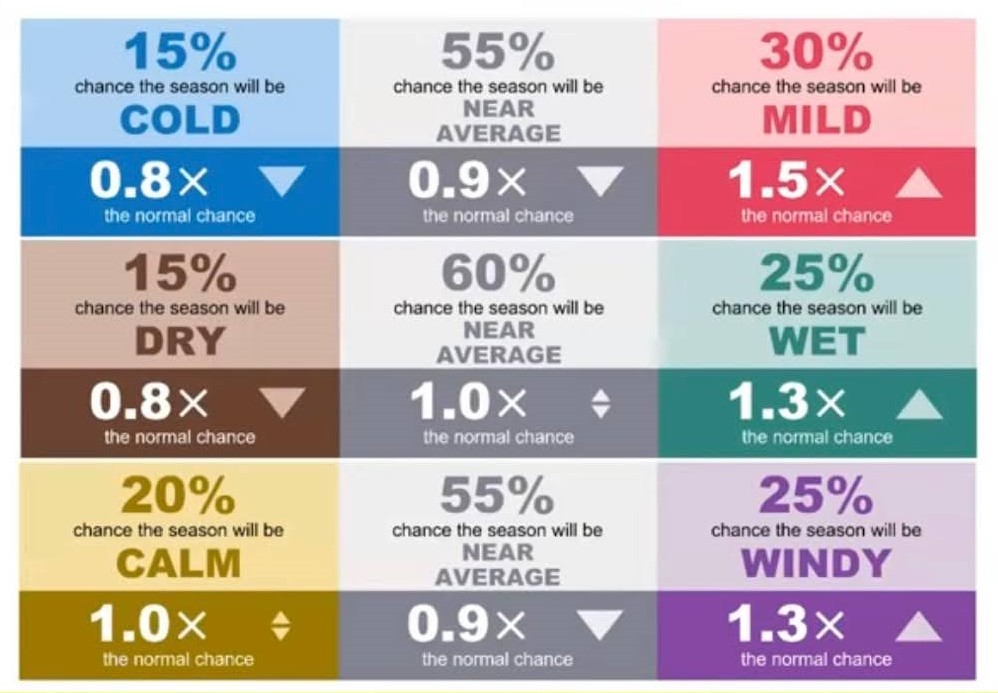

Seasonal Forecast Outlook for the Energy Sector 2023/24
The Royal Meteorological Society’s second seasonal forecasting event for the energy sector was held on 30 November. The free webinar focused on seasonal forecasts and how they are used by the energy sector, and was chaired by Matthew Wright (University of Oxford and RMetS Energy Science Engagement Fellow).
Hazel Thornton (Met Office) gave an overview of seasonal forecasts and explained the upcoming winter outlook. This was followed by two energy panellists, Ben Sloman (National Grid ESO) and Jan Dutton (Prescient Weather Ltd. and World Climate Service), who explained how seasonal forecasts are used in the sector. The event attracted hundreds of attendees.
Seasonal Forecasts
Hazel Thornton began the event introducing GloSea6, the Met Office’s state-of-the-art seasonal forecasting system, and by giving an overview of the science behind seasonal forecasts. The use of an ensemble system can help to inform which types of conditions are more likely or less likely in the upcoming season. UK winter weather is heavily influenced by the North Atlantic Oscillation (NAO), a large-scale pressure pattern measured by the difference between the pressure over Iceland and the Azores.
Hazel presented sources of skill for predicting the NAO and European winter weather, at the seasonal timescale and their current state. Large-scale climate patterns across the world can influence the NAO via remote teleconnections.
This winter, there are competing factors. A positive NAO (which tends to lead to mild, stormy and wet conditions over the UK) is favoured by:
- (In the early winter) El Niño Southern Oscillation (ENSO) sea surface temperature variations in the tropical Pacific Ocean, which is currently in a positive (El Niño) phase.
- The Indian Ocean Dipole (IOD), sea surface temperature variations in the Indian Ocean, which is currently in a positive phase.
A negative NAO (which tends to lead to cold, calm and dry conditions over the UK) is favoured by:
- (In the late winter) El Niño Southern Oscillation (ENSO), sea surface temperature variations in the tropical Pacific Ocean, which is currently in a positive (El Niño) phase.
- The Quasi-Biennial Oscillation (QBO), a band of high-level winds above the equator, which is currently in an easterly phase.
- Current Atlantic sea surface temperature patterns.
Upcoming Winter Outlook
A key message from the webinar was that a wide range of outcomes remain possible, with current climatic conditions making forecasts less certain.
For December, the Met Office system predicts an increased chance of a mild winter (1.3x the normal chance), a wet winter (1.5x normal) and a windy winter (1.8x normal). This is reflected in the shifted probability distributions in the graphs below.

For the whole winter period, the forecast also points to a mild, wet and windy winter (see figure below).
It was stressed that these statements are probabilistic: it remains possible that very different weather conditions could be experienced across the winter period.

How Seasonal Forecasts are used in the Energy Sector
We then heard from our other panellists, each giving an overview of how their organisation uses seasonal forecasts.
Ben Sloman (National Grid ESO) described how the Electricity System Operator (ESO) uses weather forecasts to ensure security of supply and plan up to a season ahead. To do this, National Grid account for past variability and utilise tools such as the Met Office decider tool. Ben also touched on how the ESO is working with the Met Office to further integrate seasonal forecasts into their decision making.
Jan Dutton (Prescient Weather Ltd. and World Climate Service, a provider of long-range forecast information) gave insights from his experience interpreting seasonal forecasts for energy traders. He spoke about how predictability and forecast confidence for the upcoming winter is lower than normal with rapid regime changes possible. This means that ‘forecast risk’ for traders is high, and they must adjust their behaviour accordingly, closely monitoring shorter-term forecasts as they are released throughout the winter.
The session ended with an engaging panel discussion and Q&A session.
Future Events
The Royal Meteorological Society hosts a number of events tailored to the energy sector. Stay up-to-date by signing up to the RMetS Energy mailing list.

